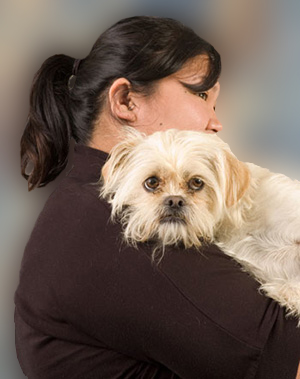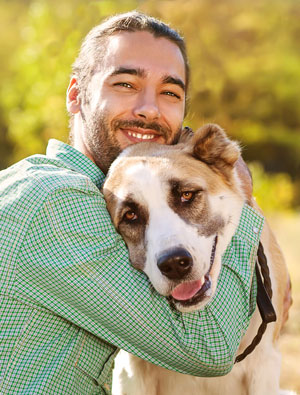Behavior Conditions: Pets that Wet
By Steve Dale
 When pets have accidents, the first assumption is that it’s a result of a behavioral issue. Maybe.
When pets have accidents, the first assumption is that it’s a result of a behavioral issue. Maybe.
It’s important that clients are taught early on that any time there is a change in a pet’s behavior, contact the veterinarian. Most pet owners make assumptions: “It’s an old dog, there’s nothing I can do,” or “The she is angry because we just returned from vacation.” Well, perhaps the dog is old – but that doesn’t mean there’s nothing the owner can do. As for the pet who inappropriately eliminates after the family returns home, there is a long list of medical conditions, from diabetes to bladder control issues which may be contributing or causing the problem.
What seems to resonate with pet owners is when veterinarians or technicians explain that if there’s a change in behavior for your individual pet —why now? Something must have precipitated that change. Sure, there may be a behavioral explanation, but behavior often changes over time, not necessarily overnight. Pet owners might not have realized that you are interested. Many pet owners just don’t know that their veterinarian wants to know about any changes in behavior.
So, with each visit, repeat the mantra: Changes in behavior mean a visit to the veterinarian.
Many pet owners are embarrassed that their pet is having accidents, and may not voluntarily report it. Because inappropriate elimination is a common reason for relinquishment (common in both cats and dogs), learning that the pet is having accidents may save a life, and obviously a client. You can likely help, but you can’t provide assistance to a condition you are unaware of – whether the problem is behavioral, medical or both.
Routinely ask about house training in dogs and litter box habits in cats, and not only puppies, kittens and senior pets – but rather all pets. An entire book can be authored regarding why pets may be incontinent, and possible behavioral explanations. I will offer a few.
For starters, ask clients for a detailed explanation. Ultimately, you need to determine if the pet is incontinent or having accidents.
The explanation may be a matter of housetraining. Many owners assume that the dog is housetrained when perhaps the dog truly is not, at least not reliably. In places like upper the peninsula of Michigan or in Minnesota, some dogs (particularly small dogs) become seasonally housetrained. Can you blame a dog for running outdoors and not “doing business” when the wind-chill is 20 below zero?
Sometimes owners have unrealistic expectations. “But my neighbor’s 10-pound dog can hold it for 10 hours.” Maybe that dog can, or maybe the neighbor is exaggerating. It doesn’t matter.
One big question: where the dog is eliminating? If the dog is eliminating by lifting a leg and/or hitting vertical surfaces, the dog might be marking (of course, reproductive status does matter, though even neutered dogs might).
Looming even larger is the question of when the dog is eliminating. If the dog piddles instantly when people come home, wagging a tail, even as the dog rolls over (particularly when men come home), the problem could be submissive urination. This behavior is most common in puppies, but can occur in dogs of any age, particularly when newly adopted.
If the dog urinates whenever the family has left the house, the dog might suffer from separation anxiety. Usually, there will be other signs of separation anxiety, however, such as the dog being over-solicitous to family members; acting anxious as people demonstrate cues that they are about to leave the house; perhaps salivating so much in the absence of people there are puddles when people arrive home; objects may be chewed on; the dog might scratch at the door; neighbors may report whining, howling and/or barking; and the dog might also lose bowel control.
If the dog is elderly, canine cognitive dysfunction syndrome should seriously be considered. As in separation anxiety, there is typically at least one other sign aside from having accidents. There’s a guide, often labeled with the acronym DISHA:
- Disorientation: Changes in spatial awareness, loss of ability to navigate around familiar obstacles (such as attempting to walk through the wrong side of a door, or getting ‘stuck’ in small rooms), wandering or pacing behavior.
- Interaction changes: Decreased interest in social interactions, petting, and greetings; acting either more aloof or more “clingy.”
- Sleep/Wake cycle changes: Restlessness or frequent waking during the night, increased sleep during daytime hours (beyond what may be considered normal for a senior pet). Sometimes crying in the night, waking and pacing overnight.
- House soiling: Not only having accidents, but doesn’t seem to realize the “oops.” If the dog seems to instantly realize, it is somewhat more likely to be a result of a medical condition.
- Activity level changes: Beyond what is normal for older dogs, significant decreased exploration and response to things, people, sounds around the house; decreased grooming, decreased appetite; increased anxiety, including restlessness, agitation, and/or an onset of separation distress.
 It’s your job to “Sherlock Holmes” what’s going on with that pet eliminating inappropriately to determine if the problem is behavioral, medical or both. Semantics play a significant role here, and the public interchanges the terminology.
It’s your job to “Sherlock Holmes” what’s going on with that pet eliminating inappropriately to determine if the problem is behavioral, medical or both. Semantics play a significant role here, and the public interchanges the terminology.
So ask about changes in the pet’s lifestyle. Is the pet less or more interactive? Is the cat drinking more water? Is there more than a single animal in the household? Have there been any recent changes in the home, from home construction to Uncle Charlie visiting for a week? Does the cat sometimes use the box and sometimes not?
All the questions listed above are questions which veterinarians and technicians should be asking clients, while simultaneously testing for appropriate medical possibilities. Answers may help veterinarians to better narrow down which medical conditions appear most likely. If it turns out the pet is having accidents solely for behavioral reasons, potentially pharmacological intervention may be used as an adjunct to behavioral modification.
If the pet needs to be professionally referred for behavioral issues, the American College of Veterinary Behaviorists has an excellent directory online. Additionally, there are many terrific veterinary behavior resources including “The Third Edition of Behavior Problems of the Dog & Cat” by Gary Landsberg, DVM, DACVB, MRCV’s, ECAWBM; Gary Hunthausen, DVM; Lowell Ackerman, DVM, DACVD, MBA, MPA. For pet owners, the American College of Veterinary Behaviorists recently authored “Decoding Your Dog: The Ultimate Experts Explain Common Dog Behaviors and Reveal How to Prevent or Change Unwanted Ones,” edited by Debra Horwitz, DVM, DACVB; John Ciribassi, DVM, DACVB and Steve Dale, CABC.
About Steve Dale
Steve Dale is the host of nationally syndicated Steve Dale’s Pet World, also heard on WGN Radio Chicago; and is the author of a twice-weekly syndicated newspaper column (Tribune Content Agency). His blog: Steve Dale’s Pet World. He’s a contributing editor at USA Weekend, contributing columnist to DVM360 (Advanstar) and special correspondent for Cat Fancy. He’s on the Board of Directors of the Winn Feline Foundation and Tree House Humane Society (Chicago).
